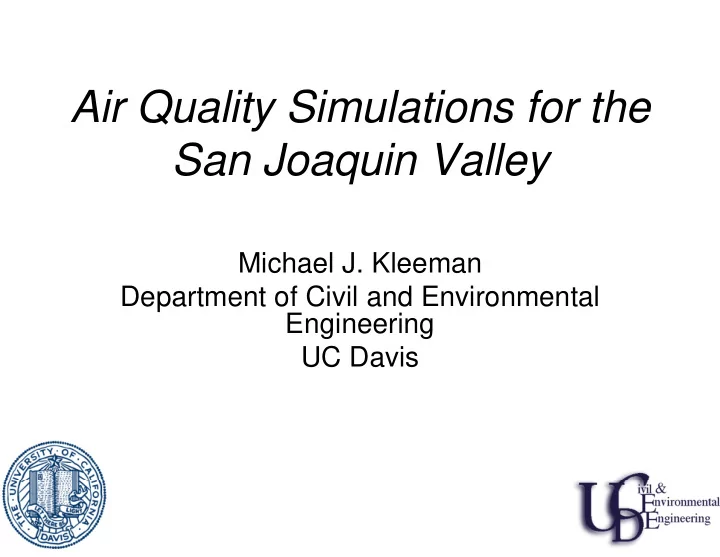

Air Quality Simulations for the San Joaquin Valley Michael J. Kleeman Department of Civil and Environmental Engineering UC Davis
Emissions Modeling System for California Fully Source- S Oriented: Separate emissions inventories for target categories Select target sources based on sources based on the emissions profile they are p y assigned
Basecase Emissions PM10 NOx ( μ g/m 2 /day) ( μ g y) (ppm*m/day) (pp y) C usta Crustal Diesel ese Food ood 0.45 Mobile Em issions 0.4 0.35 ssions Rate 0.3 0.25 0.2 Em is 0.15 0.1 NOx 0.05 ROG 0 1 7 13 19 25 31 37 43 49 55 61 67 73 79 85 91 97 103 109 115 121 127 133 139 Model Day
PM2 5 OC + EC PM2.5 OC + EC Black lines = measurements Blue circles = predictions Red Shading – Mid 50% Quantile within 10km of monitor Diurnal pattern predicted correctly at urban sites Peak values at urban sites show reasonable agreement, especially bl t i ll considering the sharp gradients Rural Angiola predictions are low Rural Angiola predictions are low. Where is the EC+OC coming from? Source: Q Ying J Lu P Allen P Livingstone A Kaduwela and M Source: Q. Ying, J. Lu, P. Allen, P. Livingstone, A. Kaduwela, and M. Kleeman “Modeling Air Quality During the California Regional PM10/PM2.5 Air Quality Study (CRPAQS) Using the UCD/CIT Source- Oriented Air Quality Model – Part I. Base Case Model Results.”, Atmos. Env., in press, 2008.
Grid Model vs. CMB Source Apportionment Angiola **D **Dust sources removed from t d f grid model Fresno Fresno **Dust sources removed from grid model Source: Q. Ying, J. Lu, A. Kaduwela, and M. Kleeman “Modeling Air Quality During the California Regional PM10/PM2.5 Air Quality Study (CRPAQS) Using the UCD/CIT Source-Oriented Air Quality Model – Part II. Regional Source Apportionment of Primary Airborne Particulate Matter.”, Atmos. Env., in press, 2008.
120 Predicted (open squares) 100 (µg m -3 ) 80 and Observed OC (solid OA Concentration 60 diamonds) using CACM 40 20 0 12/15 12/16 12/17 12/18 12/26 12/27 12/28 1/4 1/5 1/6 1/7 a.) Fresno 35 30 ncentration (µg m -3 ) 25 20 15 OA Con 10 5 0 12/15 12/16 12/17 12/18 12/26 12/27 12/28 1/4 1/5 1/6 1/7 b.) Angiola b ) A i l 100 (µg m -3 ) 80 60 60 OA Concentration 40 20 0 12/15 12/16 12/17 12/18 12/26 12/27 12/28 1/4 1/5 1/6 1/7 c.) Bakersfield
PM2.5 Nitrate, Ammonium, Sulfate Source: Q. Ying, J. Lu, P. Allen, P. Livingstone, A. Kaduwela, and M. Kleeman “Modeling Air Quality During the California Regional PM10/PM2.5 Air Quality Study (CRPAQS) Using the UCD/CIT Source-Oriented Air Quality Model – Part I. Base Case Model Results.”, Atmos. Env., in press, 2008.
Regional EC g Source Contributions Contributions Source: Q. Ying, J. Lu, A. Kaduwela, and M. Kleeman “Modeling Air Quality During the California Regional PM10/PM2.5 Air Quality Study (CRPAQS) Using the UCD/CIT Source-Oriented Air Quality Model – Part II. Regional Source Apportionment of Primary Airborne Particulate Matter.”, Atmos. Env., in press, 2008.
Regional OC g Source Contributions Contributions Source: Q. Ying, J. Lu, A. Kaduwela, and M. Kleeman “Modeling Air Quality During the California Regional PM10/PM2.5 Air Quality Study (CRPAQS) Using the UCD/CIT Source-Oriented Air Quality Model – Part II. Regional Source Apportionment of Primary Airborne Particulate Matter.”, Atmos. Env., in press, 2008.
Regional Nit Nitrate t Source Contributions
Regional NH4+ Source Contributions Source: Q. Ying, J. Lu, A. Kaduwela, and M. Kleeman “Modeling Air Quality During the California Regional PM10/PM2.5 Air Quality Study (CRPAQS) Using the UCD/CIT Source-Oriented Air Quality Model – Part III. Regional Source Apportionment of Secondary and Total Airborne PM2.5 and PM0.1.”, Atmos. Env., in press, 2008.
Recommend
More recommend